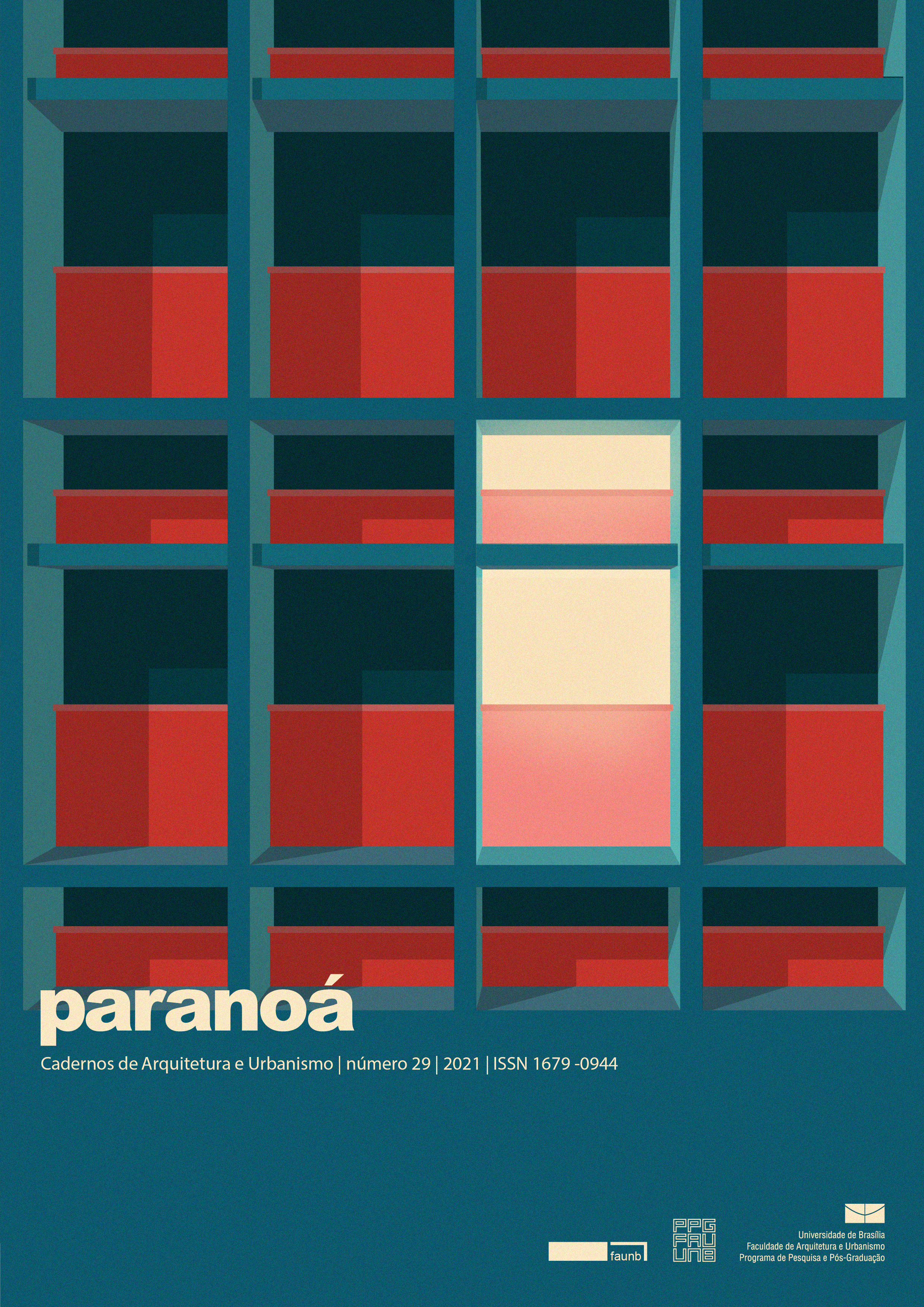Luminic performance of the association between perforated solar screen, high window and light shelf
DOI:
https://doi.org/10.18830/issn.1679-0944.n29.2021.11Keywords:
daylighting performance; perforated solar screen; high window; light shelf; computacional simulationAbstract
This research aimed to investigate the luminous performance of the association between perforated solar screen, high window and light shelf for an indoor office environment in a humid tropical climate. In the methodology, modeling was done with Rhinoceros3D + Grasshopper and simulations with DIVA-for-Rhino. As analysis parameters, the UDI (Useful Daylight Illuminances) intervals, Daylight Autonomy (DA) and Uniformity were adopted. The evaluations were made for North and West for the following models: Model I (perforated solar screen), Model II (perforated solar screen + high window) and Model III (perforated solar screen + high window + light shelf). Using Model III as a base, four more models were evaluated, varying the internal depth of the light shelf. The results point to the difficulty of the models reaching the minimum limits of DA (500lx) and Uniformity (0,6), indicating both the need to activate artificial lighting and the existence of high luminics contrasts. The Model III10 to the North and the Model III30 to the West achieved the best performance in relation to the UDI, ensuring adequate lighting in about 70% of the hours, more efficiently lighting the deep region of the environment and admitting low percentages of excessive lighting.
Downloads
References
ABNT ASSOCIAÇÃO BRASILEIRA DE NORMAS TÉCNICAS. NBR 15215-4. Iluminação natural: verificação experimental das condições de iluminação interna de edificações: método de medição. Rio de Janeiro, 2005.
ASSOCIAÇÃO BRASILEIRA DE NORMAS TÉCNICAS (ABNT). NBR ISO/CIE 8995-1. Iluminação de ambientes de trabalho – Parte 1: interior. Rio de Janeiro: ABNT, 2013.
BAKER, N.; FANCHIOTTI, A.; STEEMERS, K. Daylighting in Architecture – A European Reference Book. London: EarthscanLtd. 2010.
BOLSSONI, G.; LARANJA, A. Análise do desempenho lumínico de ambientes internos a partir da atuação de elementos vazados. XV Encontro Nacional de Conforto no Ambiente Construído (ENCAC) e XI Encontro Latino-Americano de Conforto no Ambiente Construído (ELACAC). João Pessoa, 2019a.
BOLSSONI, G.; LARANJA, A. A Influência da Refletância dos Elementos Vazados no Desempenho Lumínico. II Congesso Internacional de Arquitetura e Cidade (ARQCIDADE) e X Coletânea ARQURB. Vila Velha, 2019b.
CARTANA, R.; PEREIRA, F. MAYER, A. Estudo piloto para elementos de controle solar desenvolvidos com modelagem paramétrica e fabricação digital. Ambiente Construído, v. 18, n. 3, p. 67-82, Porto Alegre, 2018.
CHING, F. D. K. Dicionário visual de arquitetura. São Paulo: Martins Fontes, 2010.
FIGUEIRÓ, M. A Luz e a Sua Relação Com a Saúde. Lume, São Paulo, v. 8, n. 44, jun. 2010.
FREEWAN, A. A. Maximizing the light shelf performance by interaction between lightshelf geometries and curved ceiling. Energy Conversion and Management, n.51, p.1600-1604, 2010.
FREEWAN, A. A. Y. Impact of external shading devices on thermal and daylighting performance of offices in hot climate regions. Solar Energy, v.102, p. 14-30, 2014.
GONÇALVES, J.; VIANA, N.; MOURA, N. Iluminação Natural e Artificial. Procel Edifica. Rio de Janeiro, 2011.
LAMBERTS, R.; DUTRA, L.; PEREIRA, F. O. R. Eficiência energética na arquitetura. 3ª ed. São Paulo, 2014.
LAMBERTS, R.; GHISI, R.; RAMOS, G. Impactos da adequação climática sobre a eficiência energética e o conforto térmico de edifícios de escritórios no Brasil. 49p. Florianópolis: LABEEE, 2006.
MAIOLI, R. Avaliação da influência do dispositivo prateleira de luz no conforto visual em edificação comercial com entorno obstruído. Dissertação (Mestrado) – Programa de Pós-Graduação em Engenharia Civil, Universidade Federal do Espírito Santo, Vitória, 2014.
MARTAU, B. T. A Luz Além da Visão. Lume, v. 7, n. 38, jun. 2009.
MESA, N. A.; CORICA, L.; PATTINI, A. Evaluation of the potential of natural light to illuminate buildings in dense urban environment. A study in Mendoza, Argentina. Renewable Energy, n. 36, p. 2414-2423, 2011.
NABIL, A.; MARDALJEVIC, J. Useful daylight illuminances: A replacement for daylight factors. Energy and Buildings, London: Elsevier, v.38, p. 905 - 913, 2006.
OCHOA, Carlos Ernesto; CAPELUTO, Isaac Guedi. Evaluating visual comfort and performance of three natural lighting systems for deep office buildings in highly luminous climates. Building and Environment, v. 41, n. 8, p. 1128-1135, ago. 2006.
RAPHAEL, B. Active control of daylighting features in buildings. Computer-Aided Civil and Infrastructure Engineering, n.26, p.393-405, 2011.
REINHART, C. F.; WIENOLD, J. The Daylighting Dashboard: A Simulation-based Design Analysis for Daylit Spaces. Building and Environment, v. 46, n. 2, p. 386-396, 2011.
SANTOS, A. J. A Iluminação nos Edifícios: Uma perspectiva no âmbito do conforto ambiental e da eficiência energética. 1a ed. Lisboa: LNEC, 2014.
VITÓRIA. Lei n°. 4821, de 30 de dezembro de 1998. Código de Edificações do Município de Vitória. Vitória, 1998. Disponível em: <https://leismunicipais.com.br/codigo-de-obras-vitoria-es> Acesso em: 17 out. 2019.
Downloads
Published
How to Cite
Issue
Section
License
Copyright (c) 2021 Paranoá: journal of Architecture and Urbanism

This work is licensed under a Creative Commons Attribution 4.0 International License.
Autores que publicam nesta revista concordam com os seguintes termos:
- Autores mantém os direitos autorais e concedem à revista o direito de primeira publicação, com o trabalho simultaneamente licenciado sob a Licença Creative Commons Attribution que permite o compartilhamento do trabalho com reconhecimento da autoria e publicação inicial nesta revista. http://creativecommons.org/licenses/by/4.0
- Autores têm autorização para assumir contratos adicionais separadamente, para distribuição não-exclusiva da versão do trabalho publicada nesta revista (ex.: publicar em repositório institucional ou como capítulo de livro), com reconhecimento de autoria e publicação inicial nesta revista.
- Autores têm permissão e são estimulados a publicar e distribuir seu trabalho online (ex.: em repositórios institucionais ou na sua página pessoal) a qualquer ponto antes ou durante o processo editorial, já que isso pode gerar alterações produtivas, bem como aumentar o impacto e a citação do trabalho publicado (Veja O Efeito do Acesso Livre).















